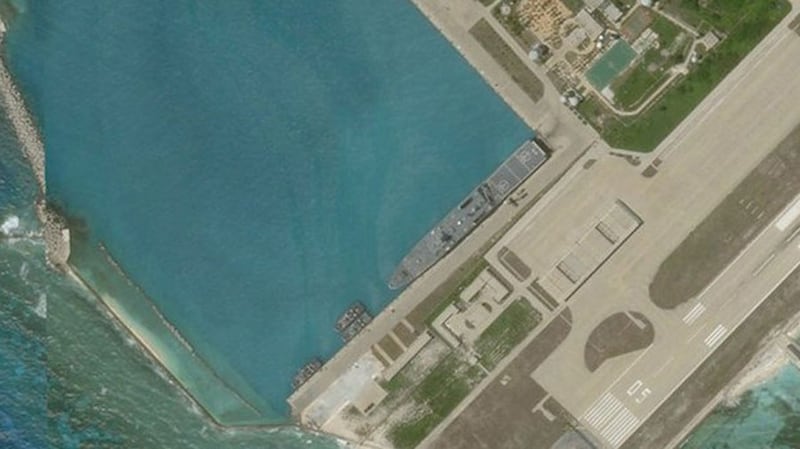China kicked off naval exercises in the contested South China Sea on Wednesday, showcasing its ability to storm and seize islands with coast guard and navy ships, according to analysts and satellite imagery.
The Maritime Safety Administration (MSA) of China’s Hainan province announced on Saturday that a naval exercise would take place in a broad swath in and around the disputed Paracel Islands from July 1-5, and prohibited ship traffic in the area during that time. Chinese state-run media reported that the drill was under way as of Wednesday.
“It looks like what they’re going to do is practice some island seizure or island security exercises, which could be a way of demonstrating to other Southeast Asian nations that China can come in and kick them off their islands,” said Bryan Clark, a senior fellow and naval expert at the Hudson Institute, a Washington-based think-tank.
He suggested that the exercise was not about simulating an attack on another military force but using the military in a police action to suppress potential civilian unrest.
“The way it appears they’re setting up their forces for the exercise, it seems like it’s more of a civilian action than it is a military force-on-force engagement,” he told RFA and its affiliated online news service BenarNews, after reviewing satellite imagery of China’s main military base at Woody Island.
The island is China’s largest occupied feature and main administrative center in the Paracels, an archipelago of rocks and reefs that is disputed between Vietnam, Taiwan, and China. It is a frequent stop-off for the People’s Liberation Army Navy (PLAN) and the China Coast Guard (CCG).
It also appears to be the staging ground for this exercise.
Satellite imagery seen by BenarNews and RFA showed a Type 071 landing helicopter dock in Woody’s harbor as of last Saturday, with three smaller ships of indeterminate class at its bow. The Type 071 is meant for amphibious warfare operations, and the three smaller ships bear a resemblance to minesweepers in service with the Chinese navy.

Notably, a handful of coast-guard vessels are also in the area of the exercise, according to vessel tracking data and satellite imagery. They may have come from the port of Sanya, in China’s Hainan province, where seven coast-guard ships were docked as of Sunday.
China passed a revision to its law governing the People’s Armed Police the same day, formally changing the PAP’s status to make it and its constituent agencies, such as the coast guard, into a branch of the armed forces alongside the navy. That revision also tasked the PAP and CCG with participating in joint military drills with other branches.
“Tying the coastguard to the People’s Armed Police makes them an extension of the part of the Chinese security apparatus that’s focused on tamping down on internal unrest,” Clark said. “One part of this exercise might be to demonstrate to put forces onto an island where the local population is getting restless.”
That has implications for China’s outlying territories, as well as that of Taiwan. China claims Taiwan as a renegade province, and Taiwan owns several small features – the Penghu Islands and Pratas atoll, for instance – that China thus claims as well. The selection of the Paracels for this exercise was because China controls every feature there, but Clark believes it’s meant to send a message around the region.
“It’s clearly to demonstrate a capability that would be exported elsewhere, and I think the use of a combination of civilian and military forces is also intended to convey a message, that, ‘We’re looking at this as more than just a military operation, and it’s intended to deal with civilian populations that may be partly Chinese and partly expatriate,’” Clark said.
“[A]nd then it’s a way to demonstrate to people outside the immediate area that this is the kind of thing that we can do in your area. Whether it’s Taiwan, the Senkakus, or in the Spratlys,” he added.
China, Taiwan and four members of the Association of Southeast Asian Nations (ASEAN) – the Philippines, Malaysia, Vietnam and Brunei – have territorial claims in the Spratly chain.
Meanwhile, there’s been other activity by China in the Paracels this week.
A ship in service with the MSA also docked at Woody Island on June 27, and appeared to be monitoring the area of the exercise as of Wednesday. A handful of aircraft landed and left Woody’s airstrip this week – including what appeared to be an early-warning surveillance aircraft on June 27. A passenger plane landed on the airstrip on Monday.
Other equipment was likely brought in for the exercise or for observation purposes. Ships called the Sansha No. 1 and No 2, which are both known to periodically resupply China’s garrison on Woody with food and equipment, have made several trips in recent weeks to the island, with the most recent one being on June 30.
Experts testify
The perpetual presence of CCG and civilian vessels in the South China Sea helps China assert its expansive maritime claims to the region, according to several experts who testified during a hearing on China’s maritime ambitions at the U.S. Congress on Tuesday.
"China wants the South China Sea to be a Chinese lake," said Greg Poling, director of the Asia Maritime Transparency Initiative and a senior fellow for Southeast Asia at the Center for Strategic & International Studies, during a hearing with the House of Representatives' Committee on Foreign Affairs.
“[General-Secretary of the Chinese Communist Party Xi Jinping] has put this issue, among a few others, at the heart of his China Dream. It underpins his claim to legitimacy. So certainly we are going to continue to see China push and push and push the envelope here because Xi has linked his political future to it.”
Additional reporting and editing by BenarNews, an RFA-affiliated online news service.
